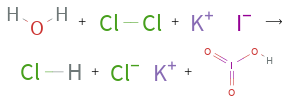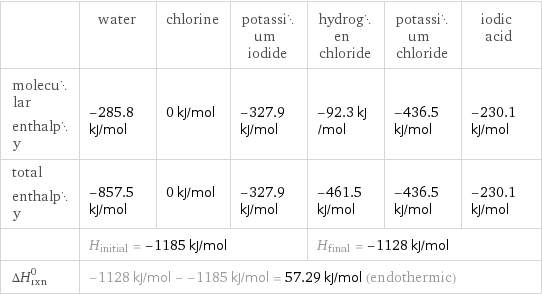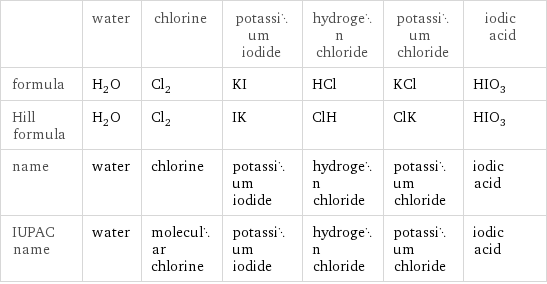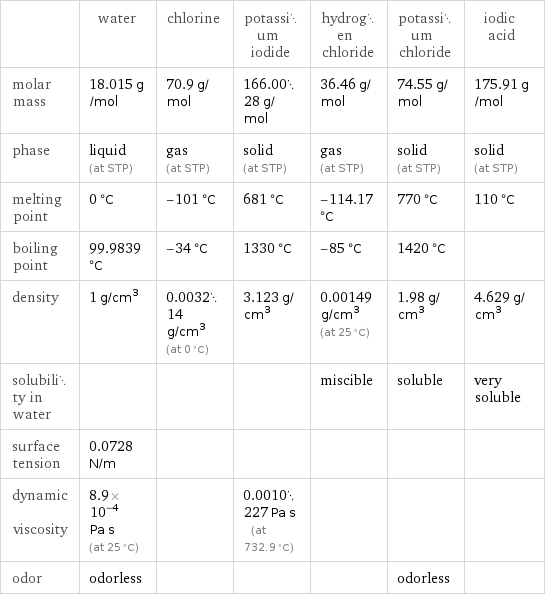Input interpretation

H_2O water + Cl_2 chlorine + KI potassium iodide ⟶ HCl hydrogen chloride + KCl potassium chloride + HIO_3 iodic acid
Balanced equation

Balance the chemical equation algebraically: H_2O + Cl_2 + KI ⟶ HCl + KCl + HIO_3 Add stoichiometric coefficients, c_i, to the reactants and products: c_1 H_2O + c_2 Cl_2 + c_3 KI ⟶ c_4 HCl + c_5 KCl + c_6 HIO_3 Set the number of atoms in the reactants equal to the number of atoms in the products for H, O, Cl, I and K: H: | 2 c_1 = c_4 + c_6 O: | c_1 = 3 c_6 Cl: | 2 c_2 = c_4 + c_5 I: | c_3 = c_6 K: | c_3 = c_5 Since the coefficients are relative quantities and underdetermined, choose a coefficient to set arbitrarily. To keep the coefficients small, the arbitrary value is ordinarily one. For instance, set c_3 = 1 and solve the system of equations for the remaining coefficients: c_1 = 3 c_2 = 3 c_3 = 1 c_4 = 5 c_5 = 1 c_6 = 1 Substitute the coefficients into the chemical reaction to obtain the balanced equation: Answer: | | 3 H_2O + 3 Cl_2 + KI ⟶ 5 HCl + KCl + HIO_3
Structures

+ + ⟶ + +
Names

water + chlorine + potassium iodide ⟶ hydrogen chloride + potassium chloride + iodic acid
Reaction thermodynamics
Enthalpy

| water | chlorine | potassium iodide | hydrogen chloride | potassium chloride | iodic acid molecular enthalpy | -285.8 kJ/mol | 0 kJ/mol | -327.9 kJ/mol | -92.3 kJ/mol | -436.5 kJ/mol | -230.1 kJ/mol total enthalpy | -857.5 kJ/mol | 0 kJ/mol | -327.9 kJ/mol | -461.5 kJ/mol | -436.5 kJ/mol | -230.1 kJ/mol | H_initial = -1185 kJ/mol | | | H_final = -1128 kJ/mol | | ΔH_rxn^0 | -1128 kJ/mol - -1185 kJ/mol = 57.29 kJ/mol (endothermic) | | | | |
Equilibrium constant
![Construct the equilibrium constant, K, expression for: H_2O + Cl_2 + KI ⟶ HCl + KCl + HIO_3 Plan: • Balance the chemical equation. • Determine the stoichiometric numbers. • Assemble the activity expression for each chemical species. • Use the activity expressions to build the equilibrium constant expression. Write the balanced chemical equation: 3 H_2O + 3 Cl_2 + KI ⟶ 5 HCl + KCl + HIO_3 Assign stoichiometric numbers, ν_i, using the stoichiometric coefficients, c_i, from the balanced chemical equation in the following manner: ν_i = -c_i for reactants and ν_i = c_i for products: chemical species | c_i | ν_i H_2O | 3 | -3 Cl_2 | 3 | -3 KI | 1 | -1 HCl | 5 | 5 KCl | 1 | 1 HIO_3 | 1 | 1 Assemble the activity expressions accounting for the state of matter and ν_i: chemical species | c_i | ν_i | activity expression H_2O | 3 | -3 | ([H2O])^(-3) Cl_2 | 3 | -3 | ([Cl2])^(-3) KI | 1 | -1 | ([KI])^(-1) HCl | 5 | 5 | ([HCl])^5 KCl | 1 | 1 | [KCl] HIO_3 | 1 | 1 | [HIO3] The equilibrium constant symbol in the concentration basis is: K_c Mulitply the activity expressions to arrive at the K_c expression: Answer: | | K_c = ([H2O])^(-3) ([Cl2])^(-3) ([KI])^(-1) ([HCl])^5 [KCl] [HIO3] = (([HCl])^5 [KCl] [HIO3])/(([H2O])^3 ([Cl2])^3 [KI])](../image_source/366a8e4cb121ad1d032a9501bb6f0906.png)
Construct the equilibrium constant, K, expression for: H_2O + Cl_2 + KI ⟶ HCl + KCl + HIO_3 Plan: • Balance the chemical equation. • Determine the stoichiometric numbers. • Assemble the activity expression for each chemical species. • Use the activity expressions to build the equilibrium constant expression. Write the balanced chemical equation: 3 H_2O + 3 Cl_2 + KI ⟶ 5 HCl + KCl + HIO_3 Assign stoichiometric numbers, ν_i, using the stoichiometric coefficients, c_i, from the balanced chemical equation in the following manner: ν_i = -c_i for reactants and ν_i = c_i for products: chemical species | c_i | ν_i H_2O | 3 | -3 Cl_2 | 3 | -3 KI | 1 | -1 HCl | 5 | 5 KCl | 1 | 1 HIO_3 | 1 | 1 Assemble the activity expressions accounting for the state of matter and ν_i: chemical species | c_i | ν_i | activity expression H_2O | 3 | -3 | ([H2O])^(-3) Cl_2 | 3 | -3 | ([Cl2])^(-3) KI | 1 | -1 | ([KI])^(-1) HCl | 5 | 5 | ([HCl])^5 KCl | 1 | 1 | [KCl] HIO_3 | 1 | 1 | [HIO3] The equilibrium constant symbol in the concentration basis is: K_c Mulitply the activity expressions to arrive at the K_c expression: Answer: | | K_c = ([H2O])^(-3) ([Cl2])^(-3) ([KI])^(-1) ([HCl])^5 [KCl] [HIO3] = (([HCl])^5 [KCl] [HIO3])/(([H2O])^3 ([Cl2])^3 [KI])
Rate of reaction
![Construct the rate of reaction expression for: H_2O + Cl_2 + KI ⟶ HCl + KCl + HIO_3 Plan: • Balance the chemical equation. • Determine the stoichiometric numbers. • Assemble the rate term for each chemical species. • Write the rate of reaction expression. Write the balanced chemical equation: 3 H_2O + 3 Cl_2 + KI ⟶ 5 HCl + KCl + HIO_3 Assign stoichiometric numbers, ν_i, using the stoichiometric coefficients, c_i, from the balanced chemical equation in the following manner: ν_i = -c_i for reactants and ν_i = c_i for products: chemical species | c_i | ν_i H_2O | 3 | -3 Cl_2 | 3 | -3 KI | 1 | -1 HCl | 5 | 5 KCl | 1 | 1 HIO_3 | 1 | 1 The rate term for each chemical species, B_i, is 1/ν_i(Δ[B_i])/(Δt) where [B_i] is the amount concentration and t is time: chemical species | c_i | ν_i | rate term H_2O | 3 | -3 | -1/3 (Δ[H2O])/(Δt) Cl_2 | 3 | -3 | -1/3 (Δ[Cl2])/(Δt) KI | 1 | -1 | -(Δ[KI])/(Δt) HCl | 5 | 5 | 1/5 (Δ[HCl])/(Δt) KCl | 1 | 1 | (Δ[KCl])/(Δt) HIO_3 | 1 | 1 | (Δ[HIO3])/(Δt) (for infinitesimal rate of change, replace Δ with d) Set the rate terms equal to each other to arrive at the rate expression: Answer: | | rate = -1/3 (Δ[H2O])/(Δt) = -1/3 (Δ[Cl2])/(Δt) = -(Δ[KI])/(Δt) = 1/5 (Δ[HCl])/(Δt) = (Δ[KCl])/(Δt) = (Δ[HIO3])/(Δt) (assuming constant volume and no accumulation of intermediates or side products)](../image_source/eedf6d0d005b54ec61393abbf38d200b.png)
Construct the rate of reaction expression for: H_2O + Cl_2 + KI ⟶ HCl + KCl + HIO_3 Plan: • Balance the chemical equation. • Determine the stoichiometric numbers. • Assemble the rate term for each chemical species. • Write the rate of reaction expression. Write the balanced chemical equation: 3 H_2O + 3 Cl_2 + KI ⟶ 5 HCl + KCl + HIO_3 Assign stoichiometric numbers, ν_i, using the stoichiometric coefficients, c_i, from the balanced chemical equation in the following manner: ν_i = -c_i for reactants and ν_i = c_i for products: chemical species | c_i | ν_i H_2O | 3 | -3 Cl_2 | 3 | -3 KI | 1 | -1 HCl | 5 | 5 KCl | 1 | 1 HIO_3 | 1 | 1 The rate term for each chemical species, B_i, is 1/ν_i(Δ[B_i])/(Δt) where [B_i] is the amount concentration and t is time: chemical species | c_i | ν_i | rate term H_2O | 3 | -3 | -1/3 (Δ[H2O])/(Δt) Cl_2 | 3 | -3 | -1/3 (Δ[Cl2])/(Δt) KI | 1 | -1 | -(Δ[KI])/(Δt) HCl | 5 | 5 | 1/5 (Δ[HCl])/(Δt) KCl | 1 | 1 | (Δ[KCl])/(Δt) HIO_3 | 1 | 1 | (Δ[HIO3])/(Δt) (for infinitesimal rate of change, replace Δ with d) Set the rate terms equal to each other to arrive at the rate expression: Answer: | | rate = -1/3 (Δ[H2O])/(Δt) = -1/3 (Δ[Cl2])/(Δt) = -(Δ[KI])/(Δt) = 1/5 (Δ[HCl])/(Δt) = (Δ[KCl])/(Δt) = (Δ[HIO3])/(Δt) (assuming constant volume and no accumulation of intermediates or side products)
Chemical names and formulas

| water | chlorine | potassium iodide | hydrogen chloride | potassium chloride | iodic acid formula | H_2O | Cl_2 | KI | HCl | KCl | HIO_3 Hill formula | H_2O | Cl_2 | IK | ClH | ClK | HIO_3 name | water | chlorine | potassium iodide | hydrogen chloride | potassium chloride | iodic acid IUPAC name | water | molecular chlorine | potassium iodide | hydrogen chloride | potassium chloride | iodic acid
Substance properties

| water | chlorine | potassium iodide | hydrogen chloride | potassium chloride | iodic acid molar mass | 18.015 g/mol | 70.9 g/mol | 166.0028 g/mol | 36.46 g/mol | 74.55 g/mol | 175.91 g/mol phase | liquid (at STP) | gas (at STP) | solid (at STP) | gas (at STP) | solid (at STP) | solid (at STP) melting point | 0 °C | -101 °C | 681 °C | -114.17 °C | 770 °C | 110 °C boiling point | 99.9839 °C | -34 °C | 1330 °C | -85 °C | 1420 °C | density | 1 g/cm^3 | 0.003214 g/cm^3 (at 0 °C) | 3.123 g/cm^3 | 0.00149 g/cm^3 (at 25 °C) | 1.98 g/cm^3 | 4.629 g/cm^3 solubility in water | | | | miscible | soluble | very soluble surface tension | 0.0728 N/m | | | | | dynamic viscosity | 8.9×10^-4 Pa s (at 25 °C) | | 0.0010227 Pa s (at 732.9 °C) | | | odor | odorless | | | | odorless |
Units
